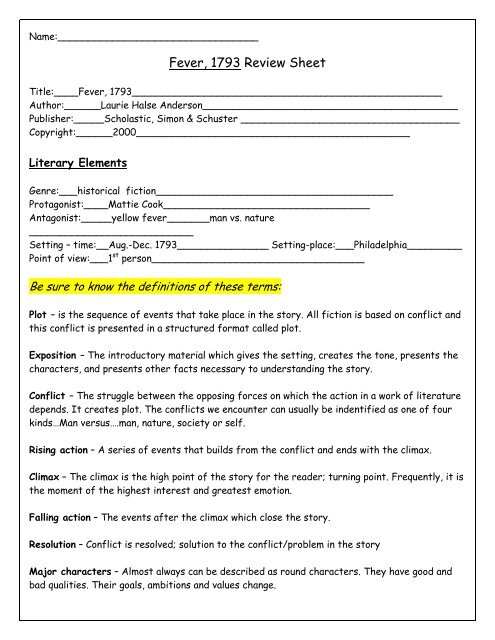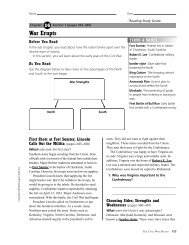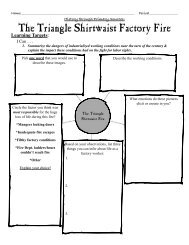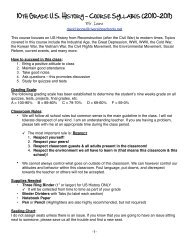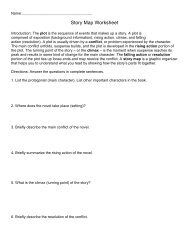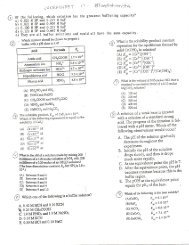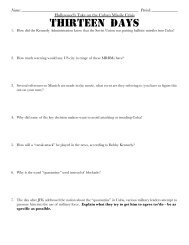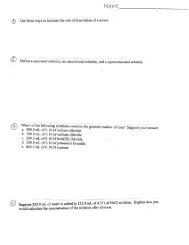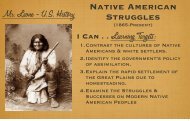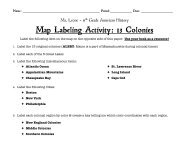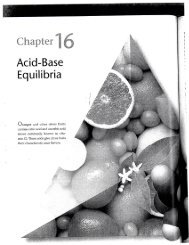Fever, 1793 Review Sheet
Fever, 1793 Review Sheet
Fever, 1793 Review Sheet
You also want an ePaper? Increase the reach of your titles
YUMPU automatically turns print PDFs into web optimized ePapers that Google loves.
Name:_________________________________<strong>Fever</strong>, <strong>1793</strong> <strong>Review</strong> <strong>Sheet</strong>Title:____<strong>Fever</strong>, <strong>1793</strong>___________________________________________________Author:______Laurie Halse Anderson__________________________________________Publisher:_____Scholastic, Simon & Schuster ____________________________________Copyright:______2000_____________________________________________Literary ElementsGenre:___historical fiction_______________________________________Protagonist:____Mattie Cook__________________________________Antagonist:_____yellow fever_______man vs. nature___________________________Setting – time:__Aug.-Dec. <strong>1793</strong>_______________ Setting-place:___Philadelphia_________Point of view:___1 st person___________________________________Be sure to know the definitions of these terms:Plot – is the sequence of events that take place in the story. All fiction is based on conflict andthis conflict is presented in a structured format called plot.Exposition – The introductory material which gives the setting, creates the tone, presents thecharacters, and presents other facts necessary to understanding the story.Conflict – The struggle between the opposing forces on which the action in a work of literaturedepends. It creates plot. The conflicts we encounter can usually be indentified as one of fourkinds…Man versus….man, nature, society or self.Rising action – A series of events that builds from the conflict and ends with the climax.Climax – The climax is the high point of the story for the reader; turning point. Frequently, it isthe moment of the highest interest and greatest emotion.Falling action – The events after the climax which close the story.Resolution – Conflict is resolved; solution to the conflict/problem in the storyMajor characters – Almost always can be described as round characters. They have good andbad qualities. Their goals, ambitions and values change.
Round character – Changes as a result of what happens to him or her; well developedcharacterDynamic character – A character who changes inside as a result of what happens tohim/her; he or she is a different person at the end [ex: Mattie]Protagonist – The main character in the storyAntagonist – The character or force that opposes the protagonist; in conflict with theprotagonist, not necessary the “bad” guy; as a force, it could be nature, society, technology.Setting – Time and/or place of storyMinor characters – Almost always flat. They have only one or two striking qualities. They areusually all good or all bad. Such characters can be interesting or amusing in their own right, butthey lack depth.Flat character – character with only one outstanding trait or feature; not developedStatic character – A character that does not internally change throughout the story.Flat characters are sometimes referred to as static characters.Point of view – angle story is told from; who tells the story and how much he/she knows.First person – The narrator is a character in the story who can reveal only personal thoughtsand feelings and what he or she sees and is told by other characters. He can’t tell us thoughtsof other characters. Uses “I” pronouns;Conflict – problem that makes the story take off. The essence of fiction. It creates plot. Theconflicts we encounter can usually be indentified as one of four kinds: man versus man, manversus nature, man versus society, or man versus self.Mood – The climate of feeling in a literary work. The choice of setting, objects, details, imagesand words all contribute towards creating a specific mood.Tone – The author’s attitude, stated or implied, toward a subject. Some possible attitudes areoptimism, seriousness, humorous, joyful. An author’s tone can be revealed through choice ofwords and details.Inference – Drawing conclusions that are not specifically stated [to imply or infer]Figurative language – Whenever you describe something by comparing it with something else,your are using figurative language. Any language that goes beyond the literal meaning of wordsin order to furnish new effects or fresh insights into an idea or subject.
Simile – A figure of speech which involves a direct comparison between two unlike things,usually with the words like or as. Example: The muscles on his brawny arms are strong as ironbars.Metaphor – A figure of speech which involves an implied comparison between to relatively unlikethings using a form of be. The comparison is not announced by like or as. Example: The road wasa ribbon of moonlight.Personification – A figure of speech which gives the qualities of a person to an animal, anobject, or an idea. It is a comparison which the author uses to show something in an entirely newlight, to communicate a certain feeling or attitude towards it and to control the way a readerperceives it. Example: The clouds were crying buckets of rain.Onomatopoeia – The use of words that mimic sounds. They appeal to our sense of hearing andthey help bring a description to life. A string of syallables that author has made up to representthe way a sound really sounds. Example: Snap! Crackle! Pop!Fiction – writing that tells about imaginary characters, places and eventsHistorical fiction – tells a story that is set in the past. The setting is usually real and drawnfrom history, and often contains actual historical persons, places, events but the maincharacters tend to be fictional.Non-fiction – writing that tells about real people, places and eventsOn the test, I will need to be able to….match up literary terms with their definitions.identify characters in the story as round or flat characters.identify if events throughout the story as true historical facts or fictional.identify literary elements and figurative language from the story when given specificlines from the text and fill in the blanks.answer short and extended response questions.Identify the following from the story:Exposition: Mother, Eliza, Grandfather and Mattie own and operate a coffeehouse inPhiladelphia. Polly, servant girl, dies.Rising Action: Mother becomes ill. Mattie and Grandfather leave for farm. Can’t find any food.Mattie gets sick. Stay at Bush Hill. Thieves break into coffeehouse. [there are many morepossibilities]
Climax [turning point]: Grandfather dies; Mattie is alone.Falling action: Mattie finds Nell and Eliza. Mattie helps Eliza. Twins/Nell get ill with fever.Mattie will share business with ElizaResolution: Mother returns and roles reversed. Frost kills fever.Find a metaphor on page 151.companion.Death was a heavy companion. You are comparing death to aFind a simile on page 55. I felt like a noodle over boiled in the stewpot. Mattie is comparingherself to a noodle, notice the word like in between the comparison making it a simile.Find an onomatopoeia example on page 54. We suffered the constant buzz of mosquitoes.Find an example of personification on page 207. I followed the jumping light into the garden.Written responseThroughout the book, Matilda and her mother never say they love each other, yet weknow they do. What evidence is there to the story that the two feel deeply for eachother?Mother doesn’t want Mattie to stay with her when she gets the fever. For her own good, shewants to send her to Ludington farm. Mother’s actions when she didn’t know where Mattie was.She left in the middle of night, very ill, to search for her on horseback. When they werereunited, there was hugging, crying. Mattie can’t imagine life without her.
Authors sometimes subject their characters to difficult tasks. What are two tasksMatilda accomplishes?Carrying for grandfather, getting yellow fever, robbers in coffeehouse, hunger, running thecoffeehouse, taking care of Nell, being alone, running a businessBased on what you know of Matilida’s character and experiences throughout the story,what, to Matilida would make a perfect day?Some possibilities are…being outside, always wanted to go to Paris, being with Nathaniel,Grandfather, Mother and Eliza. Going to market; window shopping, fishing with Nathaniel,watching hot air balloon with Nathaniel….How would Matilda’s life changed if Mrs. Cook had stayed healthy and remained with herdaughter at all times during the story?Possible Grandfather would be alive, she might not have Nell, Shem might not have helped Elizawith Free African Society, Not be partner with Eliza with expanded menu, she might not haverelationship with Nathaniel….Explain the dismal scenes that Mattie encounters while helping Eliza with her yellow feverpatients. As a student similar in age to Mattie, is that situation something that you feelyou could have handled. Provide reasons as to why or why not?Houses torn apart, patients being bled, helping patients to necessary, cleaning and washingsheets and rooms, stench would be unbearable of death, black vomit and vinegar; stench ofdying bodies, feeding patients, crying families…What is the main cause of yellow fever? Female Aedes aegypti mosquitoDoes it exist today? yesIs yes, where? Sub-Saharan Africa, parts of South America


